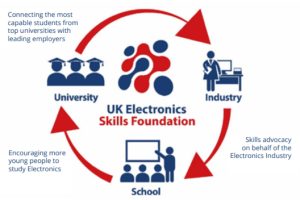 The impact of technology on our lives in modern society cannot be denied. The emergence of industry 4.0, the automation of manufacturing, has undoubtedly improved our lives, but it also comes with a substantial price.
The impact of technology on our lives in modern society cannot be denied. The emergence of industry 4.0, the automation of manufacturing, has undoubtedly improved our lives, but it also comes with a substantial price.
The main objective behind the widespread integration of technology in various sectors is to enhance efficiency, productivity and the quality of products and their manufacturing processes. The use of IoT and digitalisation has become commonplace for industry sectors, businesses, and the general public.
Waste streams
This advance has resulted in a significant influx of new electronic devices and products, many of which are disposable. Consequently, this has led to a growing waste stream that is expected to increase at an unprecedented rate. Recent data from the Global E-waste Monitor reveals that 62 billion tonnes of electronic waste was produced in 2022. This not only harms the environment but is also a hazard to human health.
Medical and military
The medical and military sectors share a commonality when it comes to the significant amount of electronic waste they generate, as both industries have distinct patterns of single use.
Small medical devices (SMDs) are a major contributor to e-waste due to their design for limited reuse to prevent cross-contamination. This not only leads to the disposal of hazardous materials, but also diminishes the availability of raw materials for future devices. A joint study by Loughborough University and the University of Leeds proposes that enabling the reuse of SMDs could potentially cut the NHS’s costs by 50%.
It is of utmost importance to emphasise that within these industries, discarded electronic devices frequently hold valuable sensitive information. If this protected data is not properly disposed of, it can be exploited, thereby holding hospitals and similar establishments accountable.
To ensure data security, it is imperative to employ secure methods for data destruction during the recycling process. These methods effectively erase any sensitive data from the devices, thereby minimising the likelihood of unauthorised access or data breaches. IBM estimates the average cost of a data breach globally to be $4.45m. The capacity to effortlessly repair and reuse products therefore, will ultimately lead to a decrease in the demand for specialised solutions to safeguard data security and minimise potential expenses for exploited data.
It has also been established that a high volume of electronics is now made up of counterfeit parts. The US Pentagon has reported that a significant portion of the electronics in circulation are counterfeit, posing a serious threat to national security. The majority of these counterfeit electronics (70%) allegedly originate from China, despite legislation in 2012 to prevent such occurrences. This alarming revelation underscores the urgent need for stricter control over e-waste and the need for a fundamental shift in mindset to safeguard national security.
Recycling
Inadequate recycling facilities, lack of legislation, and insufficient education are frequently blamed for the poor recycling of electronic devices. A crucial issue lies in the manufacturing process of these devices; they are not designed with the intention of being easily disassembled and repurposed. Instead, they are discarded, highlighting the importance of transitioning towards a circular economy to be at the core of any device.
The use of sustainable materials in the production of electronic goods, coupled with their easy disassembly, will have a significant positive effect. This approach not only helps to reduce the depletion of essential resources but also creates a commercially viable second-life market and increased profits across the supply chain.
One approach is to produce PCB assemblies using ReUSE and ReCYCLE technologies.
ReUSE is In2tec’s suite of materials, patented inks and adhesives, a manufacturing process and proprietary design techniques to deliver PCB assemblies that can be fully unzipped at end-of-life (EOL), or for repair. The materials allows areas such as cross links to provide bond strengths equivalent to solder, while being manufactured at lower temperatures and producing far fewer CO2 emissions. The technology is compatible with traditional substrates such as FR4 and other rigid and flexible alternatives.
The company says the versatility of the technology allows the opportunity for global commercialisation and a “vast reduction in the overall energy used to manufacture and to process when it reaches EOL”.
Its ReCYCLE technology is the unzipping mechanism for the PCB assemblies produced. The combination of proprietary processes permanently changes the chemistry, allowing PCB assemblies to be returned to their constituent parts.
The ability to gain undamaged and uncontaminated components for second-life use means they are both carbon-free and zero-cost, confirmed the company.
Fast facts for PCB redesign
Opportunities to transform e-waste into a valuable commodity span the entire supply chain. Manufacturers can reduce the cost spent on components and waste electrical and electronic equipment charges and lower their emissions. Additionally, the growing second-life component market provides additional revenue streams through the resale of valuable components and materials by OEMs, recyclers, and component OEMs.
Components are designed for a lifetime of 25 years and above, but on average are used for less than 4.5 years.
Around 70% of the CO2 in PCB assemblies is from the components.
More than 27.9 billion tonnes of CO2e would be spared if just 10% of the world’s annual PCBA production used ReUSE technology, said In2tec.
A typical LED lightbar manufactured using ReUSE will reduce CO2e emissions by 62.5% compared to using traditional PCBA manufacture. Once the first-life board is unzipped for reuse and/or recycling, this is reduced to just 0.001kg CO2e – equivalent to an almost 100% reduction in emissions.
 Electronics Weekly Electronics Design & Components Tech News
Electronics Weekly Electronics Design & Components Tech News



